SUBARU BRZ 2017 1.G Owners Manual
Manufacturer: SUBARU, Model Year: 2017, Model line: BRZ, Model: SUBARU BRZ 2017 1.GPages: 540, PDF Size: 6.88 MB
Page 391 of 540
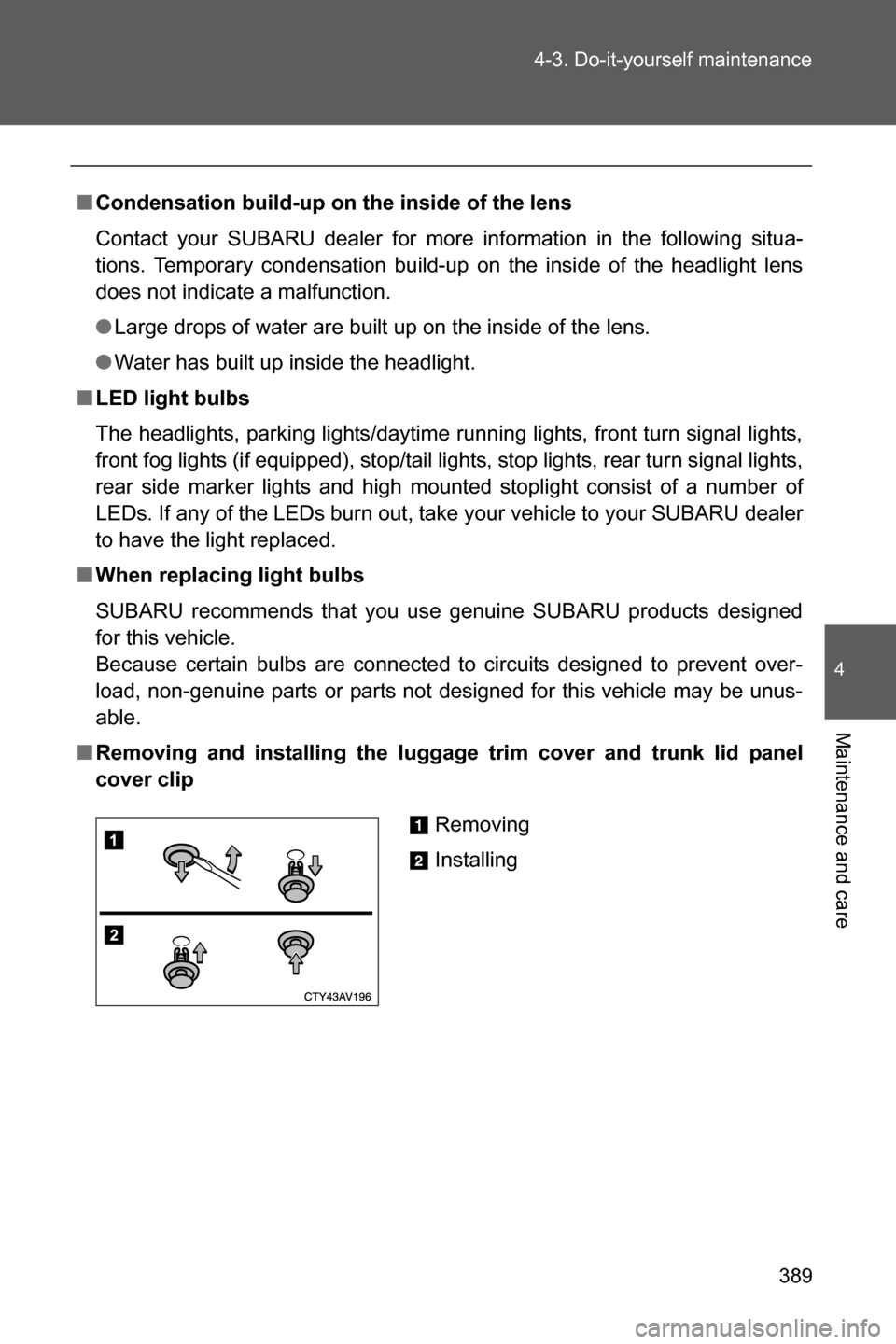
389 4-3. Do-it-yourself maintenance
4
Maintenance and care
■Condensation build-up on the inside of the lens
Contact your SUBARU dealer for more information in the following situa-
tions. Temporary condensation build-up on the inside of the headlight lens
does not indicate a malfunction.
●Large drops of water are built up on the inside of the lens.
●Water has built up inside the headlight.
■LED light bulbs
The headlights, parking lights/daytime running lights, front turn signal lights,
front fog lights (if equipped), stop/tail lights, stop lights, rear turn signal lights,
rear side marker lights and high mounted stoplight consist of a number of
LEDs. If any of the LEDs burn out, take your vehicle to your SUBARU dealer
to have the light replaced.
■When replacing light bulbs
SUBARU recommends that you use genuine SUBARU products designed
for this vehicle.
Because certain bulbs are connected to circuits designed to prevent over-
load, non-genuine parts or parts not designed for this vehicle may be unus-
able.
■Removing and installing the luggage trim cover and trunk lid panel
cover clip
Removing
Installing
Page 392 of 540

390 4-3. Do-it-yourself maintenance
WARNING
■Replacing light bulbs
●Only replace a bulb when it is cool enough to touch. Do not attempt to
replace bulbs while they are hot, as doing so may cause burns.
●Do not touch the glass portion of the light bulb with bare hands. When it is
unavoidable to hold the glass portion, use and hold with a clean dry cloth
to avoid getting moisture and oils on the bulb.
Also, if the bulb is scratched or dropped, it may blow out or crack.
●Fully install the light bulbs and any parts used to secure them. Failure to
do so may result in heat damage, fire, or water entering a light unit. This
may damage the light or cause condensation to build up on the inner side
of the lens.
■When changing the back-up lights
Stop the engine and wait until the exhaust pipes have cooled down suffi-
ciently. The lights are located near the exhaust pipe and touching a hot
exhaust pipe can cause burns.
■To prevent damage or fire
Make sure bulbs are fully seated and locked.
Page 393 of 540
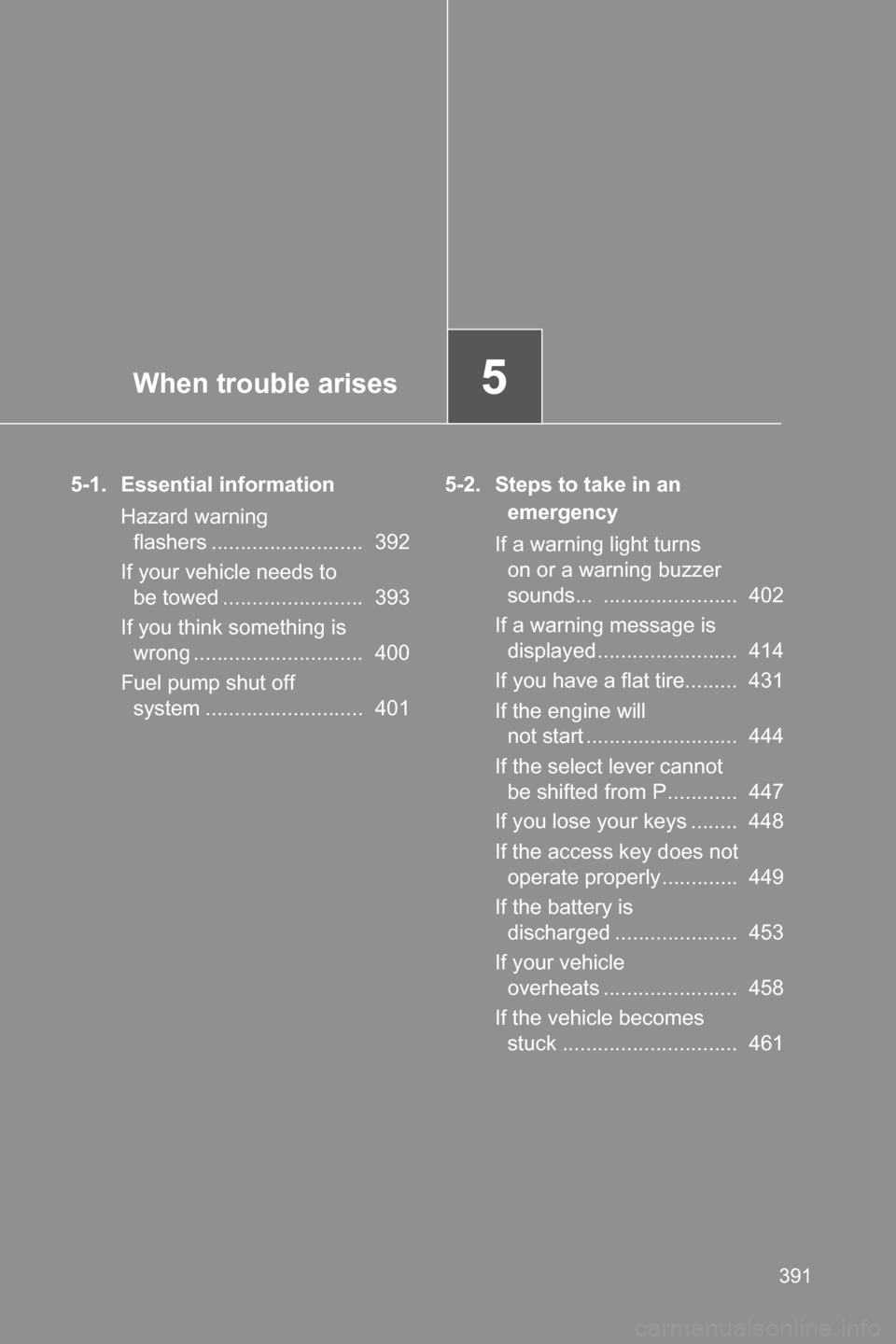
When trouble arises5
391
5-1. Essential information
Hazard warning
flashers .......................... 392
If your vehicle needs to
be towed ........................ 393
If you think something is
wrong ............................. 400
Fuel pump shut off
system ........................... 4015-2. Steps to take in an
emergency
If a warning light turns
on or a warning buzzer
sounds... ....................... 402
If a warning message is
displayed ........................ 414
If you have a flat tire......... 431
If the engine will
not start .......................... 444
If the select lever cannot
be shifted from P ............ 447
If you lose your keys ........ 448
If the access key does not
operate properly ............. 449
If the battery is
discharged ..................... 453
If your vehicle
overheats ....................... 458
If the vehicle becomes
stuck .............................. 461
Page 394 of 540
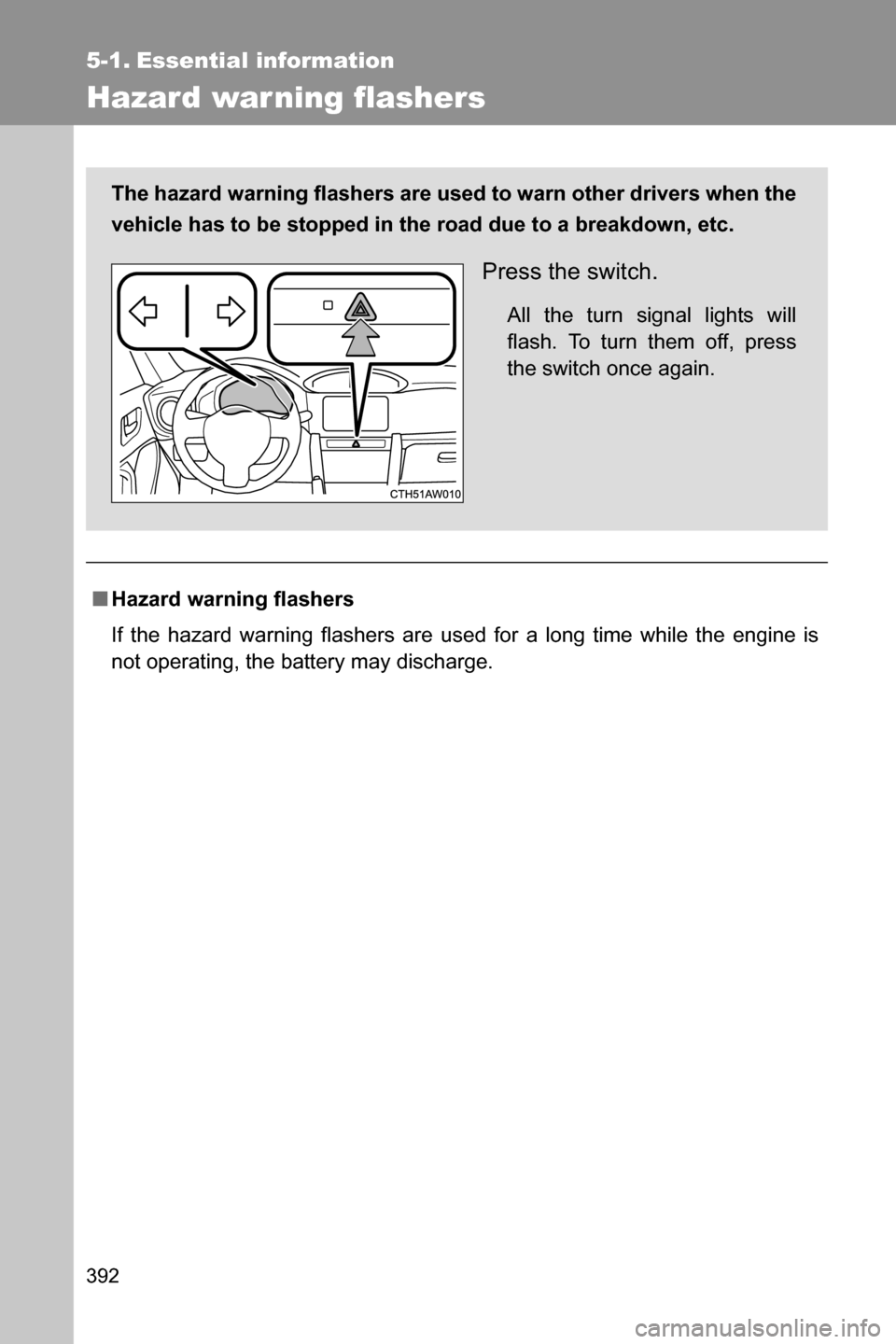
392
5-1. Essential information
Hazard war ning flashers
■Hazard warning flashers
If the hazard warning flashers are used for a long time while the engine is
not operating, the battery may discharge. The hazard warning flashers are used to warn other drivers when the
vehicle has to be stopped in the road due to a breakdown, etc.
Press the switch.
All the turn signal lights will
flash. To turn them off, press
the switch once again.
Page 395 of 540
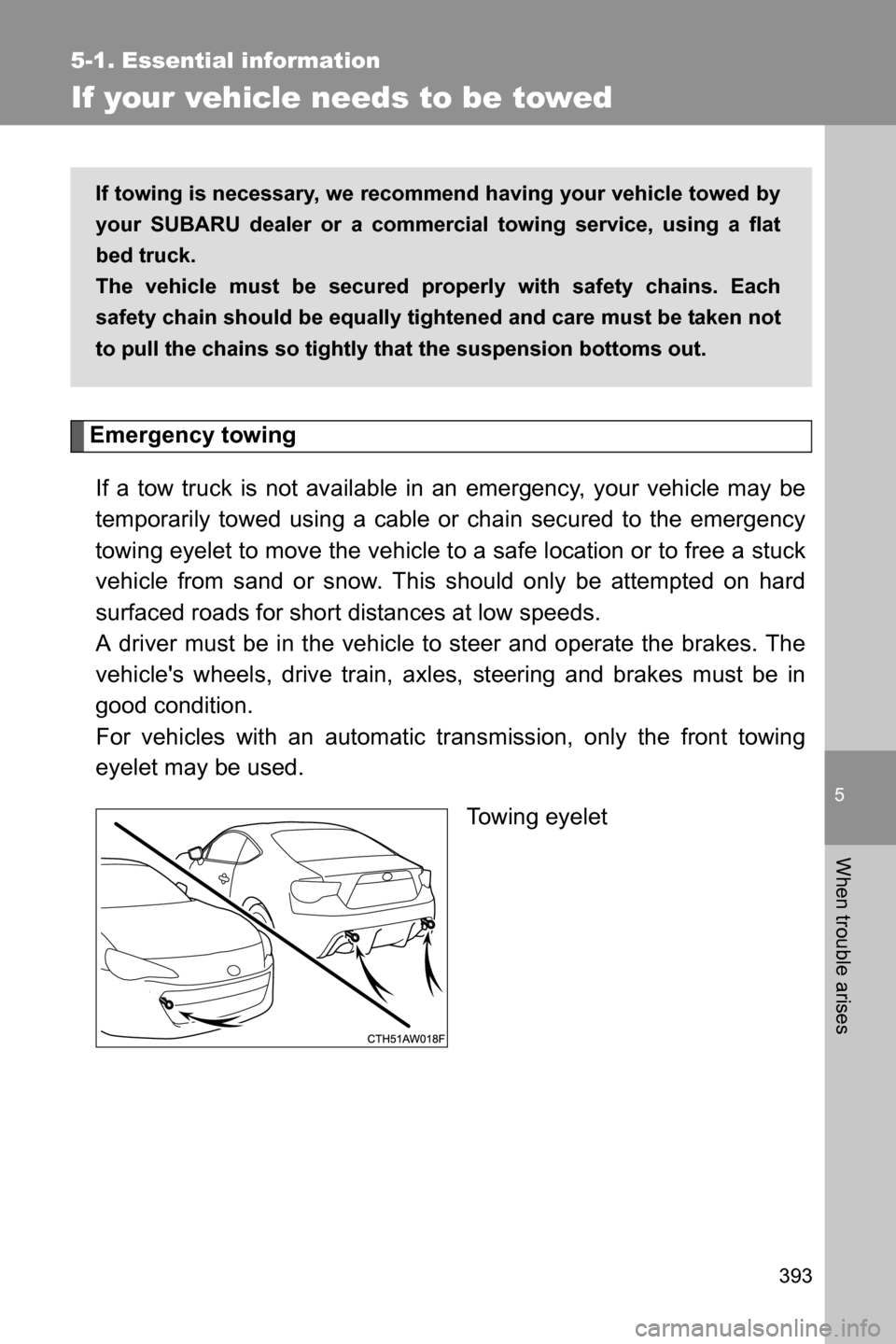
5
When trouble arises
393
5-1. Essential information
If your vehicle needs to be towed
Emergency towing
If a tow truck is not available in an emergency, your vehicle may be
temporarily towed using a cable or chain secured to the emergency
towing eyelet to move the vehicle to a safe location or to free a stuck
vehicle from sand or snow. This should only be attempted on hard
surfaced roads for short distances at low speeds.
A driver must be in the vehicle to steer and operate the brakes. The
vehicle's wheels, drive train, axles, steering and brakes must be in
good condition.
For vehicles with an automatic transmission, only the front towing
eyelet may be used.
Towing eyelet
If towing is necessary, we recommend having your vehicle towed by
your SUBARU dealer or a commercial towing service, using a flat
bed truck.
The vehicle must be secured properly with safety chains. Each
safety chain should be equally tightened and care must be taken not
to pull the chains so tightly that the suspension bottoms out.
Page 396 of 540
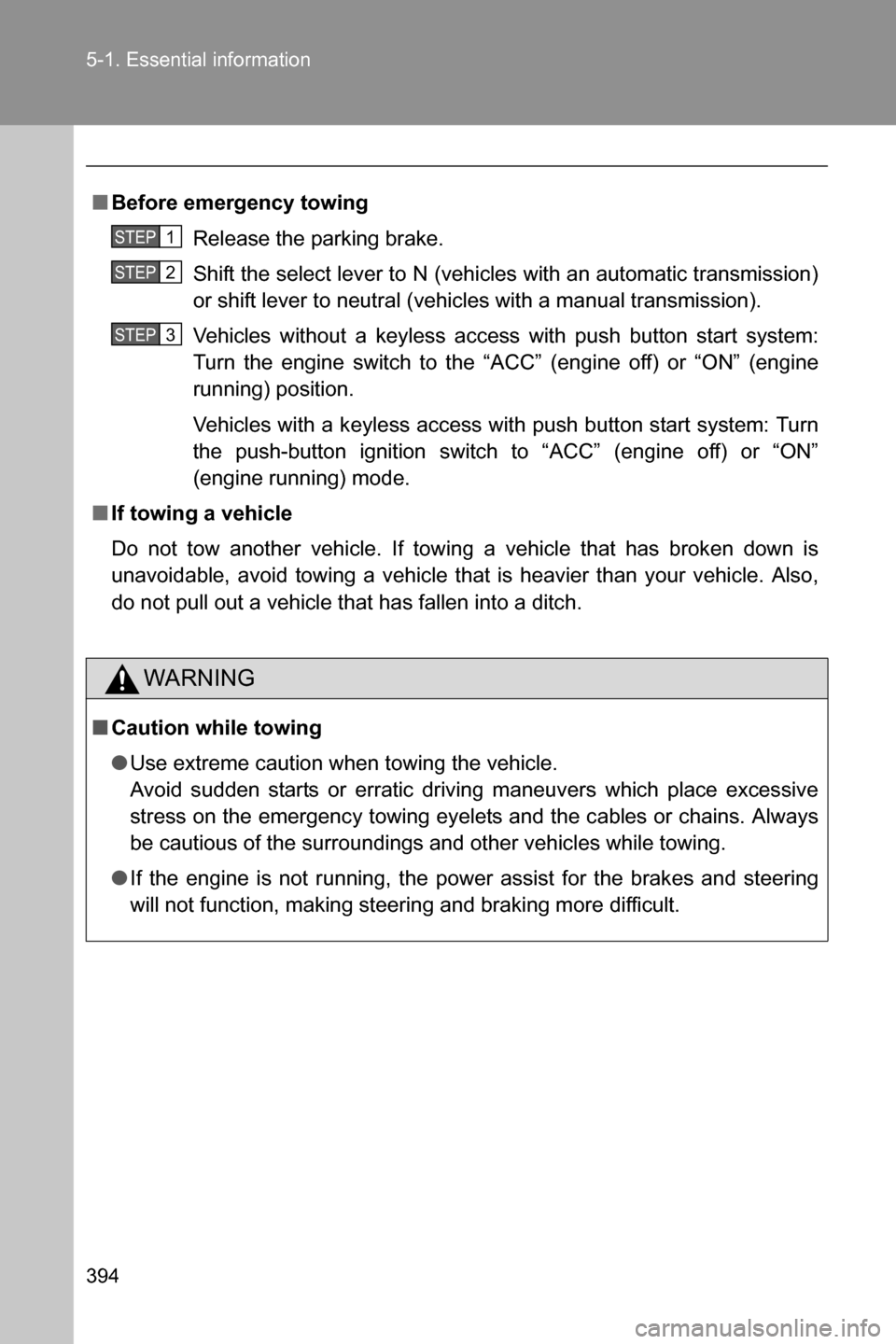
394 5-1. Essential information
■Before emergency towing
Release the parking brake.
Shift the select lever to N (vehicles with an automatic transmission)
or shift lever to neutral (vehicles with a manual transmission).
Vehicles without a keyless access with push button start system:
Turn the engine switch to the “ACC” (engine off) or “ON” (engine
running) position.
Vehicles with a keyless access with push button start system: Turn
the push-button ignition switch to “ACC” (engine off) or “ON”
(engine running) mode.
■If towing a vehicle
Do not tow another vehicle. If towing a vehicle that has broken down is
unavoidable, avoid towing a vehicle that is heavier than your vehicle. Also,
do not pull out a vehicle that has fallen into a ditch.
WARNING
■Caution while towing
●Use extreme caution when towing the vehicle.
Avoid sudden starts or erratic driving maneuvers which place excessive
stress on the emergency towing eyelets and the cables or chains. Always
be cautious of the surroundings and other vehicles while towing.
●If the engine is not running, the power assist for the brakes and steering
will not function, making steering and braking more difficult.
STEP 1
STEP 2
STEP 3
Page 397 of 540
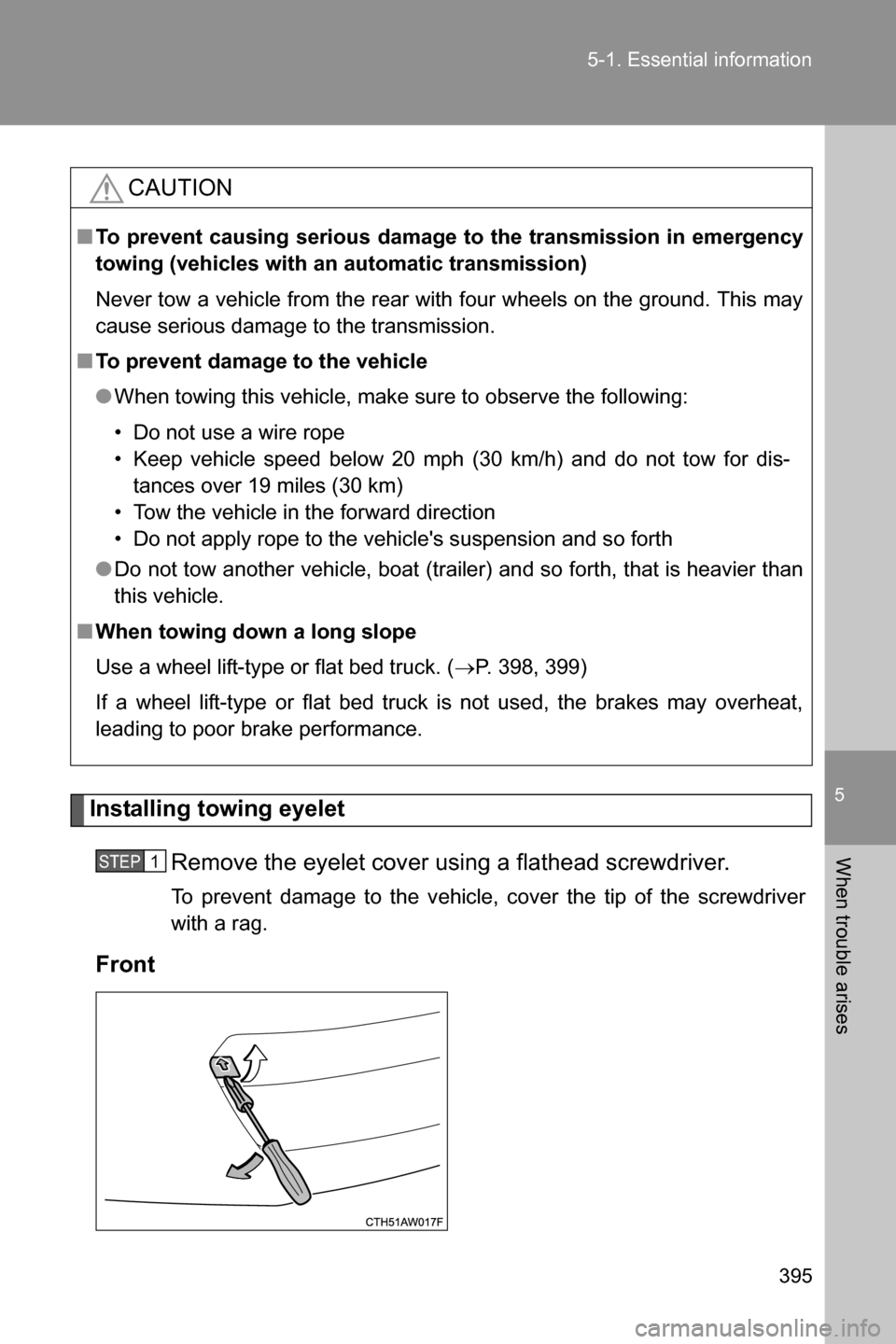
5
When trouble arises
395 5-1. Essential information
Installing towing eyelet
Remove the eyelet cover using a flathead screwdriver.
To prevent damage to the vehicle, cover the tip of the screwdriver
with a rag.
Front
CAUTION
■To prevent causing serious damage to the transmission in emergency
towing (vehicles with an automatic transmission)
Never tow a vehicle from the rear with four wheels on the ground. This may
cause serious damage to the transmission.
■To prevent damage to the vehicle
●When towing this vehicle, make sure to observe the following:
• Do not use a wire rope
• Keep vehicle speed below 20 mph (30 km/h) and do not tow for dis-
tances over 19 miles (30 km)
• Tow the vehicle in the forward direction
• Do not apply rope to the vehicle's suspension and so forth
●Do not tow another vehicle, boat (trailer) and so forth, that is heavier than
this vehicle.
■When towing down a long slope
Use a wheel lift-type or flat bed truck. (�oP. 398, 399)
If a wheel lift-type or flat bed truck is not used, the brakes may overheat,
leading to poor brake performance.
STEP 1
Page 398 of 540
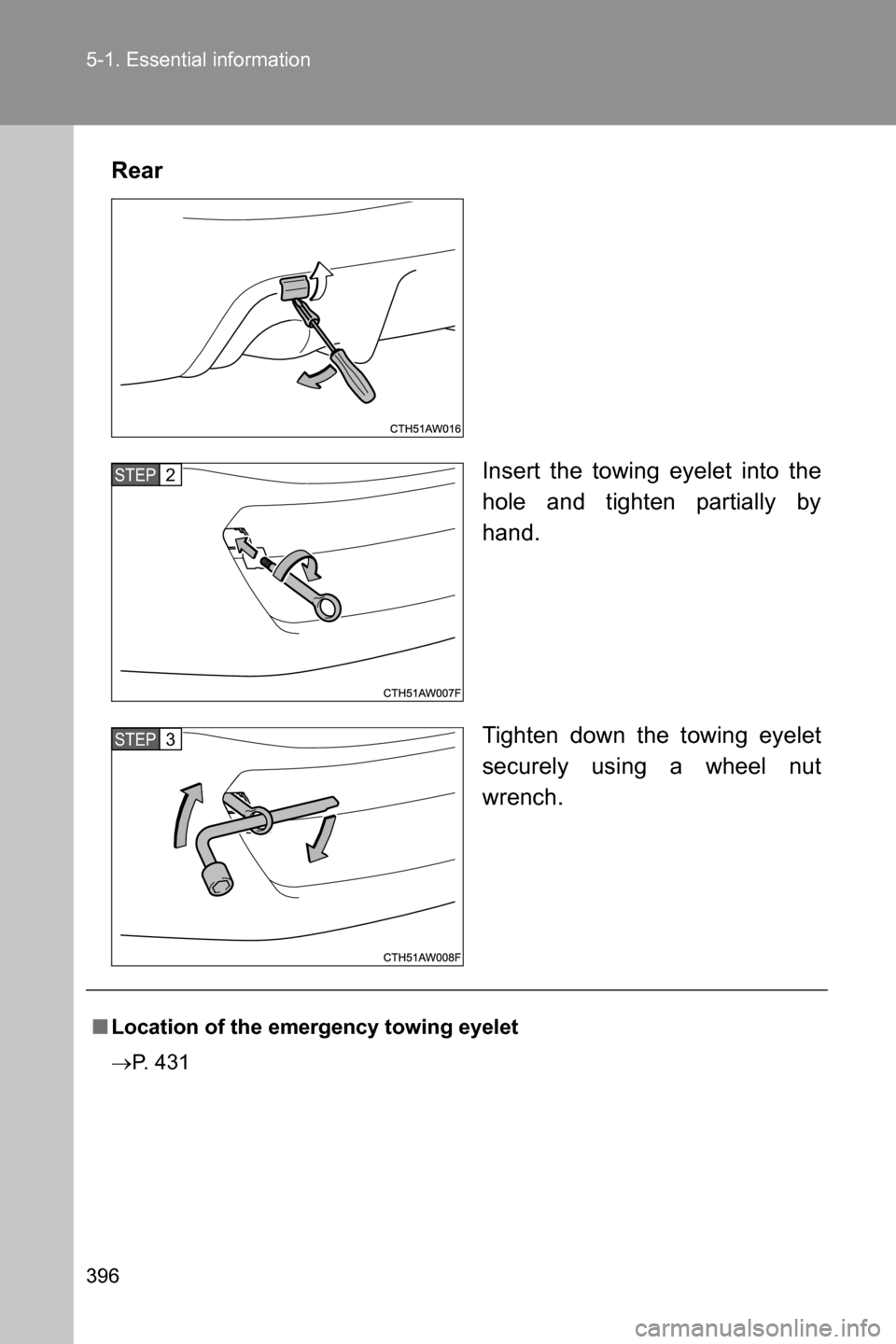
396 5-1. Essential information
Rear
Insert the towing eyelet into the
hole and tighten partially by
hand.
Tighten down the towing eyelet
securely using a wheel nut
wrench.
STEP 2
STEP 3
■Location of the emergency towing eyelet
�oP. 431
Page 399 of 540
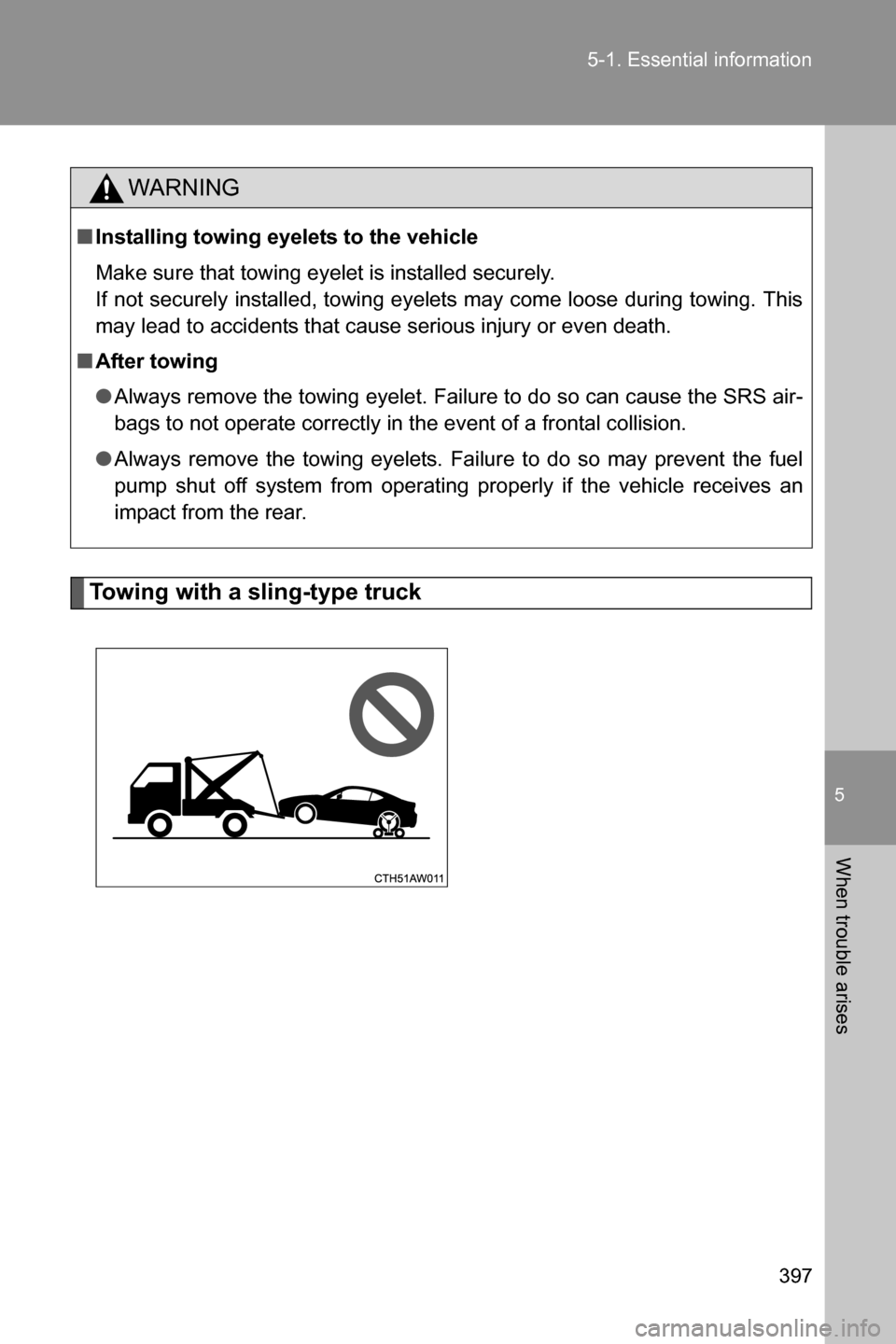
5
When trouble arises
397 5-1. Essential information
Towing with a sling-type truck
WARNING
■Installing towing eyelets to the vehicle
Make sure that towing eyelet is installed securely.
If not securely installed, towing eyelets may come loose during towing. This
may lead to accidents that cause serious injury or even death.
■After towing
●Always remove the towing eyelet. Failure to do so can cause the SRS air-
bags to not operate correctly in the event of a frontal collision.
●Always remove the towing eyelets. Failure to do so may prevent the fuel
pump shut off system from operating properly if the vehicle receives an
impact from the rear.
Page 400 of 540
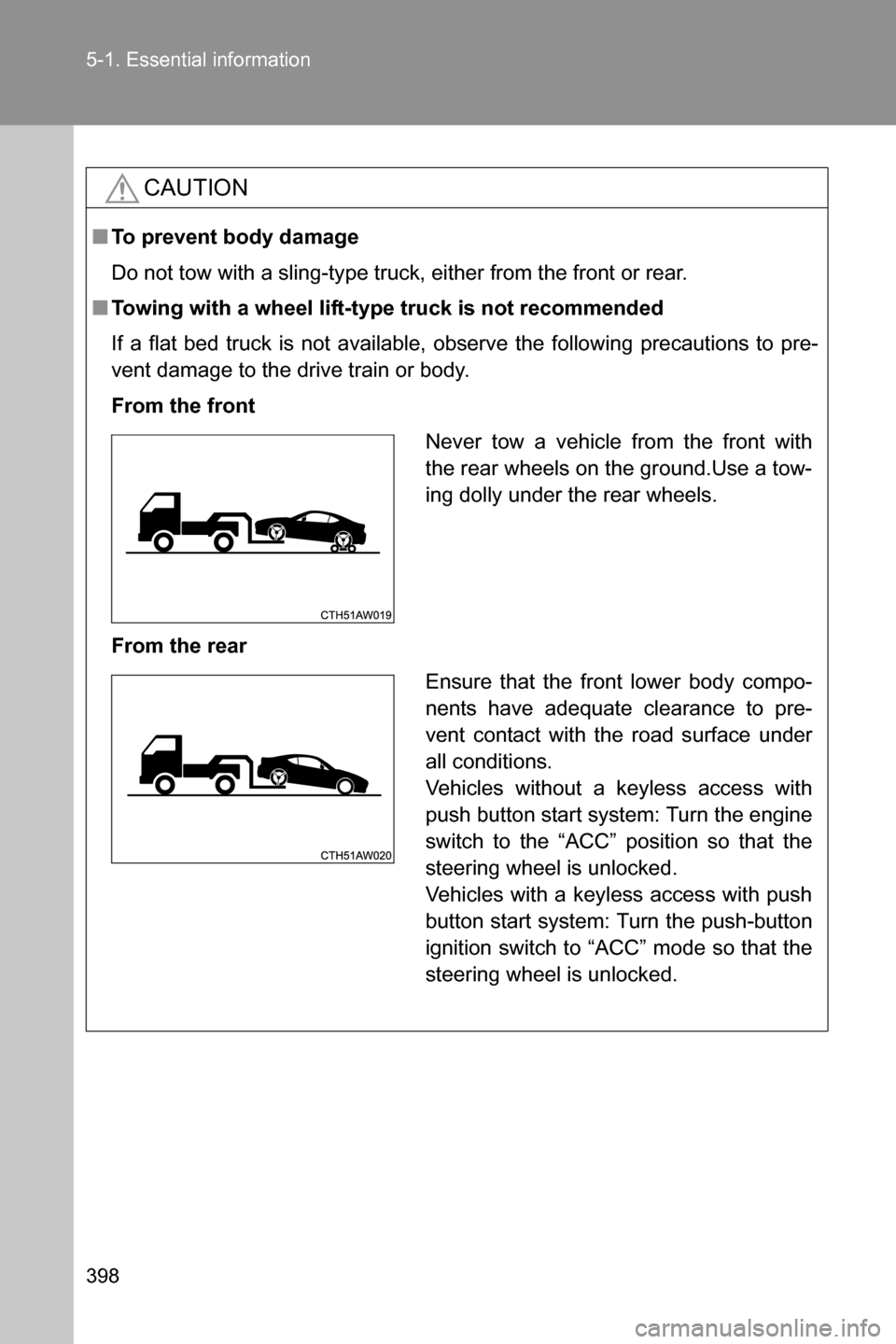
398 5-1. Essential information
CAUTION
■To prevent body damage
Do not tow with a sling-type truck, either from the front or rear.
■Towing with a wheel lift-type truck is not recommended
If a flat bed truck is not available, observe the following precautions to pre-
vent damage to the drive train or body.
From the front
From the rear
Never tow a vehicle from the front with
the rear wheels on the ground.Use a tow-
ing dolly under the rear wheels.
Ensure that the front lower body compo-
nents have adequate clearance to pre-
vent contact with the road surface under
all conditions.
Vehicles without a keyless access with
push button start system: Turn the engine
switch to the “ACC” position so that the
steering wheel is unlocked.
Vehicles with a keyless access with push
button start system: Turn the push-button
ignition switch to “ACC” mode so that the
steering wheel is unlocked.